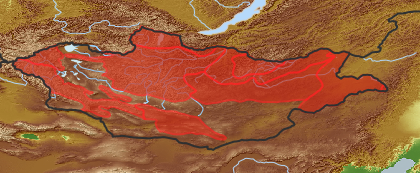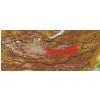| Class: | angiosperms |
| Order: | Rosales |
| Family: | Rosaceae |
| Genus: | Rosa |
| Scientific name: | Rosa acicularis Lindl. |
| Name acc. to: | Gubanov 1996 |
| Herbar: | list records  |
| Description: | Shoots densely covered with straight acicular spines and bristles. Leaves up to 15 cm long, with 5-7 large dentate leaflets, leaflets 1.5-5 cm long. Flowers dark pink or reddish, 3-6 cm in diam., solitary or by 2-3. |
| Confuse with: | R. davurica |
| Tax. Comments: | Widely distributed species with great morphological variation.
Specimens with few spines were identified as R. davurica. |
| Link to Flora of China: | http://www.efloras.org/browse.aspx?flora_id=2&name_str=Rosa+acicularis |
| open map in a new window |  |
| Habitat: | Larch and pine forests, birch kolki, forest fringes, waterside shrubberies, uremas, rocks, residual mountains, screes, stony places in forest and alpine belt (Grubov 2001). |
| Habit (i)general appearance of a plant | |
| Growth form: (i)Herb, shrub, tree or climber. | shrub, subshrub or semishrub (i)Shrub, multi-stemmed, mostly (0.2) 0.5 - 5 m high, shoots woody up to the tip
example: Caragana leucophloea   inherited by genus Rosa: shrub, subshrub or semishrub inherited by genus Rosa: shrub, subshrub or semishrub
|
| Parasite status: (i)Is the plant a half- or full parasite? | no parasite/saprophyte (i)Plant fully autonomous, leaves with chlorophyll
example: Most plants, Ranunculus  inherited by family Rosaceae: no parasite/saprophyte inherited by family Rosaceae: no parasite/saprophyte
|
| Water or terrestrial plant: (i)Where do the plants grow? | terrestrial (i)Plant grows on dry land
example: Orostachys spinosa  inherited by genus Rosa: terrestrial inherited by genus Rosa: terrestrial
|
| Leaf (i)expanded, usually photosynthetic organ of a plant (including phylloclades) | |
| Leaf development: (i)Structure and development of leaves. | with green leaves (i)Plant with green leaves  inherited by family Rosaceae: with green leaves inherited by family Rosaceae: with green leaves
|
| Leaf arrangement: (i)Arrangement of leaves at the stem. | alternate (i)One leaf per node; distiche: arranged in two vertical rows, equitant
example: Phragmites    inherited by genus Rosa: alternate inherited by genus Rosa: alternate
|
| Simple or divided leaves: (i)Are the leaves simple or completely divided in several parts? Blade of the leaf entire or (more or less) deeply dissected. Attention: There are various appearances of the leaf margin (from entire to toothed and lobed). Here, we ignore this and ask only for dissections that separate the leaf for more than one third of its length or width, whatever is smaller. Sometimes, it is difficult to tell apart compound leaves from a shoot system with simple leaves: look for stipulae and/or axillary buds at the ground of the leaves: if only some possess these structures, the others are most likely leaflets of a compound leaf. | imparipinnate / ottpinnate (i)A pinnate leaf with an central unpaired terminal leaflet  inherited by genus Rosa: imparipinnate / ottpinnate inherited by genus Rosa: imparipinnate / ottpinnate
compound (i)Composed of several similar parts  inherited by genus Rosa: compound inherited by genus Rosa: compound
pinnate (i)With leaflets on both sides of an axis, at least 2 pairs or more
example: Onobrychis   inherited by genus Rosa: pinnate inherited by genus Rosa: pinnate
|
| Petiole: (i)Leaf divided into stalk (petiole) and blade. | with (i)Leaves with petiole (stalk)   inherited by genus Rosa: with inherited by genus Rosa: with
|
| Stipule: (i)Leaflets at the base of the petiole, these are smaller and of different shape. | pair (i)A pair of free stipulae
example: Lathyrus, Trifolium   inherited by genus Rosa: pair inherited by genus Rosa: pair
|
| Leaf veination: (i)Arrangement of the main veins of a leaf. | pinnate (i)One main vein, several side veins, sometimes inconspicuous
example: Cicerbita     inherited by genus Rosa: pinnate inherited by genus Rosa: pinnate
|
| Flower (i)reproductive portion of the plant, consisting of sepals, petals, stamens, and pistils | |
| Flower appearance and pollination: (i)General appearance of the flower. | attractive, animal-pollinated (i)attractive and coloured flowers, mostly large, attracting surely animals
example: Trollius, Rosa, Chamaerhodos  inherited by family Rosaceae: attractive, animal-pollinated inherited by family Rosaceae: attractive, animal-pollinated
|
| Perianth arrangement: (i)Attention: in some plants, flowers may be dimorphic in different ways (dioecious or gynodioecious). If flowers vary, record the characters of the most showy flowers. | double, different (i)Two types of perianth leaves, differently coloured (sepals: outer periant leaves, usually greenish, and petals: inner perianth leaves, usually coloured)
example: Parnassia    inherited by genus Rosa: double, different inherited by genus Rosa: double, different
|
| Flower symmetry: (i)Symmetry of the perianth leaves. Attention: to assess this character, look on sepals, petals and stamens, but neglect carpels and ovary. | radiary, regular (actinomorphic) (i)More than two axis of symmetry
example: Saxifraga: 5; Iris: 3   inherited by family Rosaceae: radiary, regular (actinomorphic) inherited by family Rosaceae: radiary, regular (actinomorphic)
|
| Flower form: (i)common forms of flowers ? Veronica | simple (flat) - Do not confuse with inflorescences as in some Asteraceae (i)Petals spread out, flower appearing flat
example: Mollugo, Trientalis, Pulsatilla, Saxifraga   inherited by family Rosaceae: simple (flat) - Do not confuse with inflorescences as in some Asteraceae inherited by family Rosaceae: simple (flat) - Do not confuse with inflorescences as in some Asteraceae
|
| Sepal number: (i)Number of sepal leaves (outer perianth leaves, calyx leaves, mostly greenish). Attention, this character applies only for flowers separated in sepals and petals, thus excluding most monocots. Be aware of the bracts (involucral leaves) of Asteraceae flowerheads, do not qualify these as sepals! Be also aware in Rosaceae is often an epicalyx developed, in this case count all parts. | 5 (i)
example: Polemonium  inherited by genus Rosa: 5 inherited by genus Rosa: 5
|
| Petal / Tepal number: (i)Number of petal leaves (inner perianth leaves, usually coloured). | 5 (i)
example: Potentilla  inherited by genus Rosa: 5 inherited by genus Rosa: 5
|
| Petal / Tepal fusion: (i)To which degree are the petal leaves connected? Petals sympetalous. | free (i)all petal leaves separate from each other
example: Anthriscus  inherited by family Rosaceae: free inherited by family Rosaceae: free
|
| Spur: (i)A hollow, slender, sac-like appendage of the perianth leaves, storing nectar. | no spur (i)Flower without appendage
example: Peganum  inherited by family Rosaceae: no spur inherited by family Rosaceae: no spur
|
| Stamen number: (i)Attention: We ask for the reproductive organs of the flower dispersing pollen. Count only fully fertile stamens, not staminodia (e.g. Parnassia). | > 10 (i)
example: Nymphaea, Callianthemum, Rosa  inherited by genus Rosa: > 10 inherited by genus Rosa: > 10
|
| Stamen fusion: (i)To which degree are the stamens fused? Attention: Whereas the pollen sacs itself are often free., their stalks (filaments) may be fused. Here, we count them as fused if they are together over at least one thirth of their length. | free (i)Stamens with separate bases
example: Malus  inherited by family Rosaceae: free inherited by family Rosaceae: free
|
| Carpel number: (i)Number of carpels (carpel: forming a simple pistil or part of a compound pistil, modified leaf). | > 5  inherited by genus Rosa: > 5 inherited by genus Rosa: > 5
|
| Carpel fusion: (i)To which degree are the carpels (modified leaf forming simple pistil or part of a compound pistil) fused. | free (i)Carpels entirely free
example: Geum, Aconitum  inherited by genus Rosa: free inherited by genus Rosa: free
|
| Ovary position: (i)For entirely or partly fused carpels, describe their position in relation to the insertion point of perianth leaves (best done by doing a longitudinal section of a flower). | inferior (i)Ovary below the point where perianth leaves are inserted, always fused to an ovary
example: Vaccinum    inherited by genus Rosa: inferior inherited by genus Rosa: inferior
|
| Sex: (i)Distribution of male and female organs among flowers, only most commonly cases. | bisexual, hermaphrodite (i)All or nearly all flowers of a plant with male and female parts
example: Haplophyllum, Chenopodium  inherited by genus Rosa: bisexual, hermaphrodite inherited by genus Rosa: bisexual, hermaphrodite
|
| Inflorescence (i)flowering part of a plant, describes the arrangement of the flowers on the flowering axis | |
| Inflorescence: (i)Structure of the inflorescence. | Solitary flowers (i)Each flower grows on an own leafy stem there may be more than one, if the plant has many leafy shoots
example: Viola, Saxifraga hirculus, Rubus arcticus  inherited by genus Rosa: Solitary flowers inherited by genus Rosa: Solitary flowers
|
| Appearance: (i)Outer look of the inflorescence. | terminal (i)Inflorescence is the highest point of the plant and may consist of a single flower only
example: Cypripedium, Rhaponticum, Ligularia sibirica, Echinops  inherited by genus Rosa: terminal inherited by genus Rosa: terminal
|
| Fruit (i)the seed bearing organ, with or without adnate parts; a ripened ovary and any other structures which are attached and ripen with it. Aggregate fruits are handled like simple fruits for determination. | |
| Consistency: (i)Fleshy fruits or dry fruits, see dispersal adaptations for further classification. | fleshy (i)Usually non dehiscent; with a fleshy (swollen because of a high water content) outer shell, flesh edible at least for animals
example: Prunus, Amygdalus, Malus  inherited by genus Rosa: fleshy inherited by genus Rosa: fleshy
|
| Type of fruit: (i)Common fruit types (including pseudocarp). | Aggregated fruits (i)     inherited by genus Rosa: Aggregated fruits inherited by genus Rosa: Aggregated fruits
hip (rose hip) (i)A berry-like structure composed of an enlarged hypanthium surrounding numerous achenes
example: Typical fruit in Rosa   inherited by genus Rosa: hip (rose hip) inherited by genus Rosa: hip (rose hip)
|
| Opening of fruit: (i)Mode of dehiscence at maturity to release seeds. | not opening / indehiscent (i)Fruits remain closed at maturity and disperse with seeds inside
example: Corylus (nut), Vaccinium (berry)  inherited by genus Rosa: not opening / indehiscent inherited by genus Rosa: not opening / indehiscent
|
| Dispersal: (i)Appearance of fruit or seed (if single) and adaptations to dispersal. | Fleshy, edible (i)At least parts with a soft tissue edible at least for some animals (not necessarily for humans)  inherited by genus Rosa: Fleshy, edible inherited by genus Rosa: Fleshy, edible
|
| Shoot/Stem (i)a young stem or branch | |
| Spines, thorns or prickles: (i)Shoot with conspicuous spines, thorns or prickles. | prickles (i)A small, sharp pointed outgrow of the epidermis or bark, detactable without tearing tzhe plant
example: Galium uliginosum  inherited by genus Rosa: prickles inherited by genus Rosa: prickles
|
| Root / shoot below ground (i)plant part below ground (in most cases), including below ground shoots, without leaves | |
| Root type: (i)Organisation of the roots. | allorhizous (i)Plant with a conspicuous tap root, one larger tap root with side roots
example: Dicotyledonae  inherited by order Rosales: allorhizous inherited by order Rosales: allorhizous
|
| Distribution (i)region where the plant is likely to be found | |
| Distribution (Veg. Zones): (i)acc. to Grubov 1952 | Khubsgul (i)In distribution data often named as '1' 
Khentei (i)In distribution data often named as '2' 
Khangai (i)In distribution data often named as '3' 
Mongol-Daurian (i)In distribution data often named as '4' 
Great Khingan (i)In distribution data often named as '5' 
Khobdo (i)In distribution data often named as '6' 
Mongolian Altai (i)In distribution data often named as '7' 
Middle Khalkha (i)In distribution data often named as '8' 
East Mongolia (i)In distribution data often named as '9' 
Gobi-Altai (i)In distribution data often named as '13' 
acc. to: "Gubanov 1996 |
| Distribution Khangay: (i)acc. Flora Khangaya 1989 | I
II
IV
V
VI
|